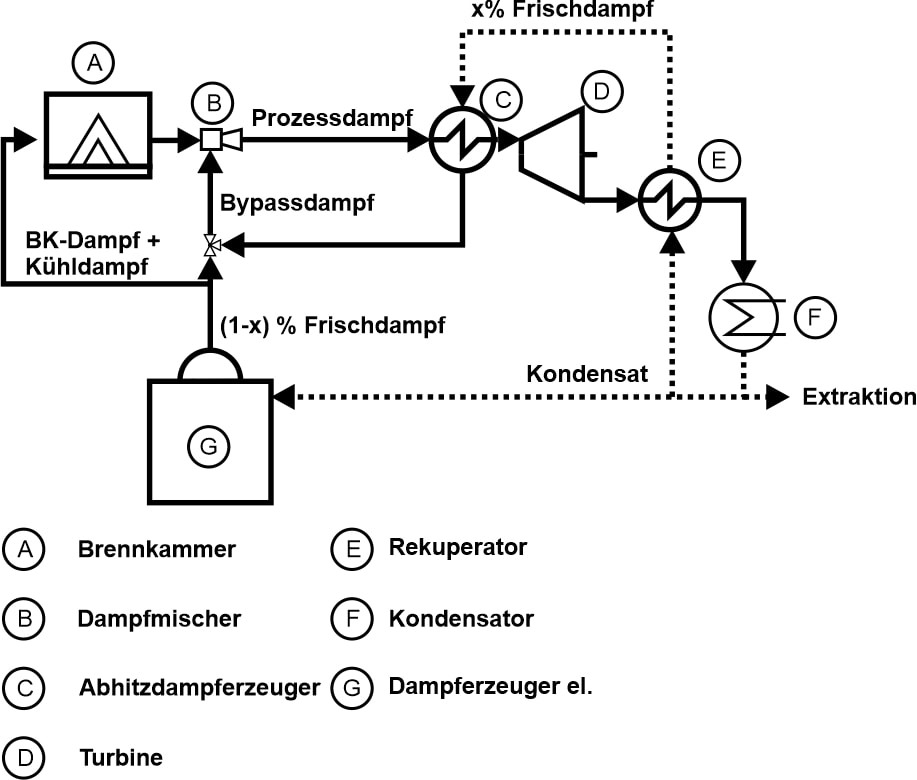Research
Hydrogen-Fueled Power Plants
Zero-Emission Power Plants: Modeling of Processes with Stoichiometric Combustion of Hydrogen and Oxygen in Steam and Development of a Prototype The stoichiometric combustion of hydrogen in thermal power plants is in the focus of research due to the challenges of the energy transition. A largely unexplored variant of thermal power plants are closed processes in which hydrogen is burned by adding oxygen in steam. Initial concepts were already presented in the late 1970s. The biggest advantage of these processes is the absence of climate-damaging gases, as the water vapor produced during combustion is condensed. They also promise thermal efficiencies of over 70%. The best-known execution is the Graz process. The research field of H2 power plants deals with two topics: 
1- Modeling of power plants with the process simulation program Aspen. The goal is to investigate new concepts and optimize existing processes in terms of efficiency. At the same time, an interface between Aspen and Matlab is being created to enable automated initialization and evaluation of the Aspen models.
2- Construction of a prototype, based on which initial operational data is obtained and control concepts are tested. This is done in parallel with the hydrogen combustion chamber test rig. It’s about integrating the combustion chamber into a closed process and moving from theory to practice.
Students. Due to the wide range of tasks, positions for final theses or activities as a scientific assistant are continuously open. Topics include: process simulation, programming, thermodynamics, CFD, construction, and experimental planning. Many of these activities can be done remotely. Cover letters or inquiries to:
David Bocandé
T: +49 406541-3714
E: [email protected]
Test Rigs
Measurement Technology & Media Supply
Measurement Equipment
The Laboratory for Fluid Machinery is excellently equipped for various measurement tasks in single and multiphase flows. Apart from the fundamental measurement of pressures and temperatures on surfaces or using flow probes, 2D and 3D LDA and PIV systems are available for capturing flow fields. In multiphase flows (e.g., droplet-laden), the size of particles can also be determined using the existing PDA and shadowgraphy systems. For the measurement of very small particles in the sub-micrometer range based on light extinction, the necessary equipment and expertise are also available.
Furthermore, at the laboratory’s combustion chamber test rig, LIF and UV-LIF systems are available for capturing processes during combustion, as well as corresponding devices for emission measurement.
Measurement Technology LSM
Air and Steam Supply
Steam Supply:
– Natural gas-fired flame tube steam boiler with superheater and hot steam surface cooler.
– Maximum steam output: 10 tons/hour.
– Maximum fresh steam condition: 17 bar / 280 °C.
– Bypass line with adjustable water injection.
Air Supply:
– The central air supply system of the laboratory consists of two large radial compressors, which can be operated either individually, in parallel, or in series.
1 Compressor in Operation:
– Maximum pressure ratio: 2.
– Maximum air flow: 27 kg/s.
2 Compressors in Operation:
– Maximum pressure ratio: 3.7.
– Maximum air flow: 18 kg/s.
– The desired air inlet temperature at the test rig is set using an aftercooler.
Furthermore, there is a fan available for air supply for smaller test rigs, with a maximum volume flow of 10 m³/s and a maximum pressure increase of 1600 Pa.
Letzte Änderung: 29. January 2024